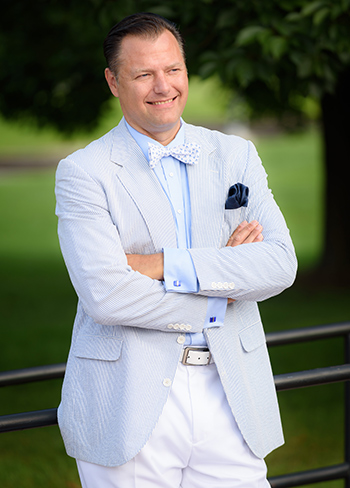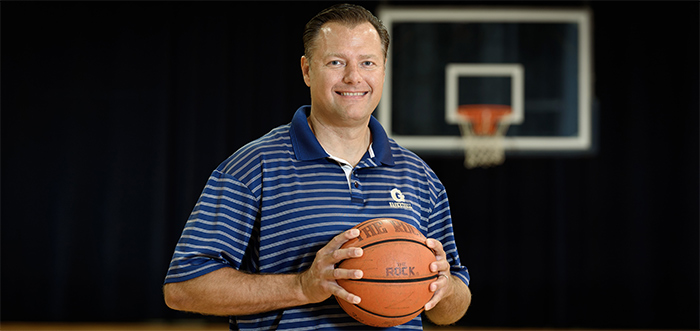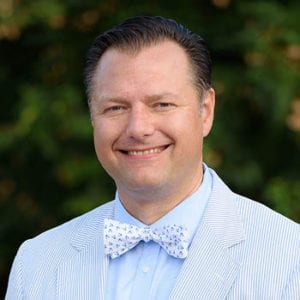Coaching clients toward their financial goals
Coaching clients toward their financial goals

John Zinaich, CFP, ChFC, CLU • Boonsboro, MD
Zinaich Capital and Risk Management • Founders Financial Securities, LLC
Read full biography below
Proactive Advisor Magazine: John, what was your path to becoming the founder of your own advisory firm?
I feel fortunate to have had a variety of experiences in the industry and believe that has given me a unique perspective in addressing the needs of our clients. My father has been an agent for one of the largest insurance firms in the U.S. for many years, and that first prompted my interest in financial services. After graduating college with a business degree, I joined that firm and spent several years in the claims-processing area, with a fair amount of field work. It was a high-quality company with great products and strong customer service. Working in that culture and seeing firsthand the importance of the protection of assets for families was a very beneficial experience.
I moved on to the brokerage business and was hired by one of the nation’s top wire house firms. I received excellent training in their investment philosophy at the time, which was primarily classic asset allocation and modern portfolio theory. While I enjoyed my time there and learned a lot about the ins and outs of investment markets, it was, at the end of the day, primarily a transactional relationship that we had with clients. I felt I wanted more of a holistic planning relationship and joined one of the oldest community banks in Maryland. As a wealth manager, I was able to establish fuller relationships with clients of the bank. I was also often brought into branches to consult with other advisors on more complicated situations that involved areas such as business planning, high-net-worth clients, and estate planning.
“The core concept we talk about is risk mitigation and attempting to manage the impact of downside exposure.”
Before founding my firm, I moved from the bank to join a group of independent advisors. This gave me a tremendous amount of freedom to build my own business. I incorporated all of my experience and training to date into a well-honed financial-planning process that I use to this day. I also gained exposure to their proven marketing practices and built strong relationships with experienced advisors, many of whom had different areas of specialization. After about two years, I decided to move out on my own and am very pleased with how my practice has grown and evolved over the past decade or so.
What is your overall philosophy in working with your firm’s clients?
 We are a full-service financial-planning practice that specializes in estate planning, business planning, charitable planning, retirement planning, and wealth management. As an integral part of this approach, we address the full range of clients’ financial needs during the various stages of their lives, including generational planning and life, health, and disability coverages. Developing a mutually beneficial relationship with our clients is our first priority, and that revolves around the attributes of trust, knowledge, respect, and experience. Our firm values what our clients value, listens to and understands their goals, and then presents well-researched options on how to work toward those goals.
We are a full-service financial-planning practice that specializes in estate planning, business planning, charitable planning, retirement planning, and wealth management. As an integral part of this approach, we address the full range of clients’ financial needs during the various stages of their lives, including generational planning and life, health, and disability coverages. Developing a mutually beneficial relationship with our clients is our first priority, and that revolves around the attributes of trust, knowledge, respect, and experience. Our firm values what our clients value, listens to and understands their goals, and then presents well-researched options on how to work toward those goals.
I believe each client or family situation presents a different puzzle to solve, and the most effective way to do this is to work together in a consultative fashion. This cooperation does not end once a plan is in place. After a plan has been implemented, it is crucial that both parties communicate regularly to ensure that the plan is effective, and to make changes when life changes—whether that involves a birth, retirement, moving a residence, financial market turmoil, losing a job, inheritance, a death, or any other event that could have a financial impact. My greatest career satisfaction comes from helping others, and this drives everything we do on behalf of our clients.
How does your financial-planning process inform an investment plan for clients?
I spend a lot of time with clients learning about their life situation, current financial outlook, and future aspirations before addressing any specific investment recommendations. I think I have been blessed with the ability to help people uncover their true financial needs and wants and then to work closely with them to address those needs. Our process has several initial in-depth consultative sessions that cover qualitative factors first and then hard financial facts such as income, expenses, assets, and liabilities. We also use a state-of-the-art methodology to ascertain client attitudes around risk.
Following these sessions, I draft an investment policy statement, which I present in great detail. At this point, I can ascertain if a client feels comfortable with my approach. When the investment policy statement is approved conceptually, only then can I go to work on developing the specifics of an actionable plan and timetable, covering not just their investments but, usually, a full range of financial-planning needs. This is where I am basically saying, “Here’s how I feel we can improve your financial situation and how we can set a road map toward your goals.” Essentially, my clients want peace of mind knowing that their assets are allocated to the types of diversified investments that are specifically suited to them.
I am proud that I work with clients from all walks of life and do not place an emphasis on account minimums. When I started out, other advisors told me I needed to set a minimum at $500,000 in terms of client assets or else I would end up with all small accounts. I told myself that I was not going to do that, as my intention was to serve the needs of all clients. I have come to experience that people who have $50,000 in assets will recommend other people with $50,000. My high-net-worth clients will recommend other high-net-worth clients. It really proved my point that if you just set out to help people, it will all work out in the end.
Describe your investment philosophy and how you position that to clients.
It’s all about setting the appropriate goals, placing an emphasis on risk-adjusted returns, and educating clients around expectations. The investment policy statement for a conservative client will obviously look different from one for a more aggressive client. However, no matter the client’s risk profile, we will be conservative in projecting their plan’s expected returns. They’re each seeking different types of risk-adjusted returns, but risk is at the heart of our discussion.
Managing risk is what has attracted me to third-party investment managers who have strategies that are designed to manage downside risk in different types of market environments. The first criteria I look for in an outside investment manager is not how their approach performed in a bull market but how it did during the last two severe bear markets of the dot-com era and the credit crisis.
I explain to clients that there are only three things the market can do: go up, stay sideways in a range, or go down. The current positive press around passive indexed investing sounds good in a bull market, when everything is going up. But those articles tend to leave out discussion of the drawdowns a passive fund, such as an S&P 500 fund, can face during a bear market. Active, risk-managed strategies will generally not outperform during a bull market, but they can perform decently. They also have the opportunity to deliver returns in a sideways market. Where they gain a huge edge is in a bear market.

This is the type of discussion I have with clients, making the case that active strategies can strategically adjust as market conditions change. That makes perfect sense to clients once they understand market cycles and that they do not always have to leave their portfolio fully exposed to downside risk. No strategy, of course, can eliminate all risk. The core concept we talk about is risk mitigation and attempting to manage the impact of downside exposure.
I basically have three rules concerning clients I want to work with, and these relate strongly to our discussions about financial planning and investment strategies. First, they need to value the guidance that I can provide and be open to coaching. Second, they need to be motivated to work on improving and managing their financial situation with that guidance. Third, they need to be nice, decent people who respect me and who I respect in return. These types of clients will be receptive to the educational messages I communicate and will feel free to have an open, direct, and frank dialogue. I will spend as much time as necessary with each client to make sure their comfort level and understanding is at a high level. In the end, I believe this pays huge dividends for both clients and our firm.

Set up “ideal” criteria for acquisition targets
Advisory firms can drive profitable growth through the acquisition of other practices that present a favorable opportunity for expanding a client base. As part of his current effort to acquire other practices, here are the “ideal” criteria John Zinaich (CFP, ChFC, CLU) looks for:
1. The practice is well-established, has a long-term and stable client base, and the current owner is willing to work toward an efficient transition of the equity in current client relationships.
2. There are long-term benefits to the client base of the existing firm in moving to a practice centered on holistic financial and investment planning.
3. The practice includes services that complement his firm, such as tax planning.
4. The practice should be small to midsized, with assets under management of at least $10 million.
 John Zinaich is the president and founder of Zinaich Capital and Risk Management, located in Boonsboro, Maryland. He has worked in the financial-services industry for 26 years, with a varied background at one of the nation’s largest insurance companies, a well-known national brokerage firm, and a small community bank.
John Zinaich is the president and founder of Zinaich Capital and Risk Management, located in Boonsboro, Maryland. He has worked in the financial-services industry for 26 years, with a varied background at one of the nation’s largest insurance companies, a well-known national brokerage firm, and a small community bank.
Mr. Zinaich says this extensive experience, combined with his industry certifications, “has helped our firm be well-positioned to provide holistic financial-planning advice to our clients.” He is a Certified Financial Planner (CFP), Chartered Financial Consultant (ChFC), and a Chartered Life Underwriter (CLU).
Mr. Zinaich attended Youngstown State University on partial academic and athletic scholarships and finished his business degree at Frostburg State University. He resides in Maryland with his wife and four children, and says, “family time is the most important thing in the world to me.” Related to his role coaching high school basketball, his family has hosted several students over the past five years.
A former member of the Financial Planning Association and the Frederick Estate Planning Council, Mr. Zinaich has been a past board member of his church, and his family has been linked to a little brother through the Big Brothers Big Sisters of America organization. He has been an avid basketball and soccer coach for many years and “believes greatly in the life lessons that young men and women can gain from playing sports—team work, loyalty, patience, hard work, determination, and goal setting.”
Disclosure: Registered representative with and securities and investment advisory services offered through Founders Financial Securities, LLC. Member FINRA, SIPC, and registered investment advisor.
Photography by Kurt Holter

